The Astronomical Society of Kansas City will be onsite at Union Station’s Science City with telescopes and volunteers. The planetarium will air the NASA event live just after midnight.
Hope to see you there!
Sunsets, Stars, West, Wind
The Astronomical Society of Kansas City will be onsite at Union Station’s Science City with telescopes and volunteers. The planetarium will air the NASA event live just after midnight.
Hope to see you there!
I decided to take a day of vacation from work yesterday. Even though the Transit of Venus wouldn’t start until shortly after five o’clock in the afternoon, I didn’t want to miss any of it, especially the beginning. I wiled away the day reading, baking bread and making strawberry shortcake. I also tested the scope (but not the camera) around noon, getting a clear picture in my mind of the current configuration of our nearest stellar neighor.
As the clock approached four in the afternoon, I laid out all my equipment, sunscreen, sunglasses, umbrella and collapsable chair, making sure I had everything I would need for an observing session that would last several hours on a slightly warmer than normal and sunny June afternoon. My prayers had been answered in part, at least, for clear skies (releatively clear, except for some humidity, haziness and wispy stratus clouds). I proved to be my own worst enemy, though, because while washing my hair, I managed to get an entire palmful of shampoo in my right eye, which happens to be my ‘good’ eye – the one I use to focus and observe with. My eye watered for the rest of the day, but at least didn’t appear to have any problems focusing.

I packed everything in the car and had my husband drive me to my previously selected observing spot. It’s my new favorite location for observing and photographing day-time astronomical events that require an unobstructed view of the western horizon (and it’s close to home so I don’t spend time and gas money to get there). In the last few weeks from this spot, I’ve observed a solar eclipse, earthshine on the moon (with Venus nearby), a lunar eclipse and yesterday my first (and only) Venus transit. I unpacked the equipment, said goodbye to my husband (who would return later to catch a glimpse of the ‘black dot’ that would be Venus crossing the sun) and started setting up the scope. My dad joined me, sometime between 4:30 and 5:00 p.m., as he got tied up with rush hour traffic on US-73 southbound from north Leavenworth to south Lansing.
I had parked the scope when I used it around noon, leaving it in a polar mount configuration. I knew I wouldn’t be able to re-align it to Polaris when I transported it from my backyard to this other site, but I could get ‘in the ballpark’ enough to track the sun and take photographs. The most challenging aspect of taking photographs through the Meade ETX-90 with the Pentax K100D attached to it is focusing. The viewfinder on the camera presents a very small ‘live’ view of the object (in this case the filtered image of the sun). The sunspots, which appeared very large and distinct when observing through the telescopes eyepiece under magnification, were tiny pinpricks through the camera. Focusing became easier once the large black dot of Venus appeared, but before that, resolving the sunspots proved troublesome. With that in mind, here’s a photo from immediately prior to the transit of Venus commencing:
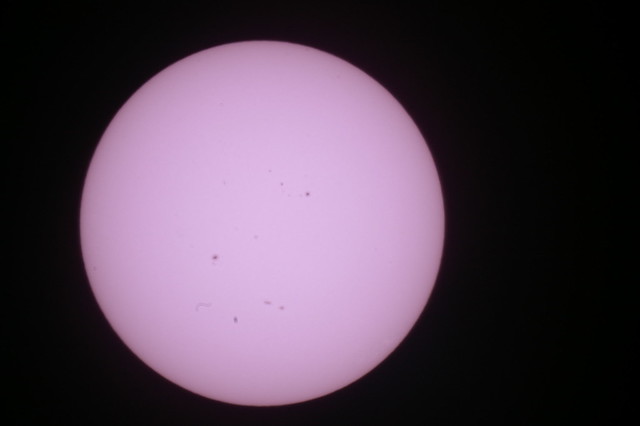
I choose this location also in the hopes that people would see me on the hill overlooking Main Street and stop by to have a look (or at least ask me what the heck I thought I was doing so I could then explain and convince them to take a look). Over the course of the next three hours, I had between fifteen and twenty people stop and take a look at the transit through my telescope. The first group to stop had seen me there before, back in May for the solar eclipse. I asked them to wait a couple of minutes because I was taking a serious of photographs to capture the first and second contacts of Venus:

One of the last group included an entire family who had seen me on their way to a baseball game (for their young son) and stopped on the way back after the game. They pursuaded their grandmother to leave the car and take a look. By that time though, the sun had entered some thicker clouds and was close to setting, so the light getting through the solar filter created a dim red hazy image, but Venus’ black sillouette was still clearly visible.
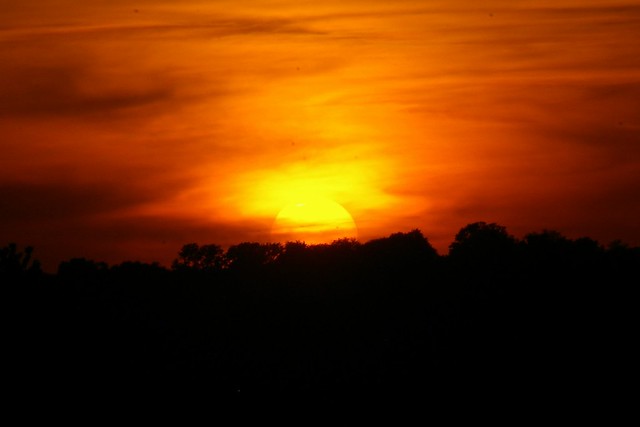
After the sun set, Dad and I packed up the equipment and said our goodbyes. We were both tired, from standing, sometimes bending over, occasionally sitting, but always baking in the late afternoon June sun. I went home, ate some leftovers, grabbed 140 photos off my cameras memory card and selected one or two to upload and share with friends and family. I didn’t have the energy last night to review so many photos. I called my daughter, who lives in Texas, to see if she had a chance to witness the transit. She reported she did, as her university setup several scopes near their Environment Sciences lab building and she got to see the sun through a hydrogen-alpha filter (which I am saving up for as they are not cheap). I also tuned in to NASA’s live feed both on my laptop and via DirecTV (channel 289) for a few minutes before succumbing to my need for sleep.
First thing this morning when I awoke, I began sifting through the photos and settled on thirty-nine good shots to upload and share. I discovered, though, that I have some debris on my camera mirror and will need to have it cleaned. See if you can find the debris that looks like a sunspot but travels around the surface of the sun (but not the frame of the picture).
Later this week, I will attempt to qualify for an observing certificate from NASA using the Paralax Activity Method #1 (I can’t do the other two because I only witnessed about half of the transit before the sun set). But first I’ll read and review the Mathematics of the Transit of Venus to make sure my aging brain remembers college math.
I am so glad I had the opportunity to witness the Transit of Venus. I sincerely hope you took advantage to sneak a peak. Only our grandkids (or great-grandkids) will see the next one, in 2117.
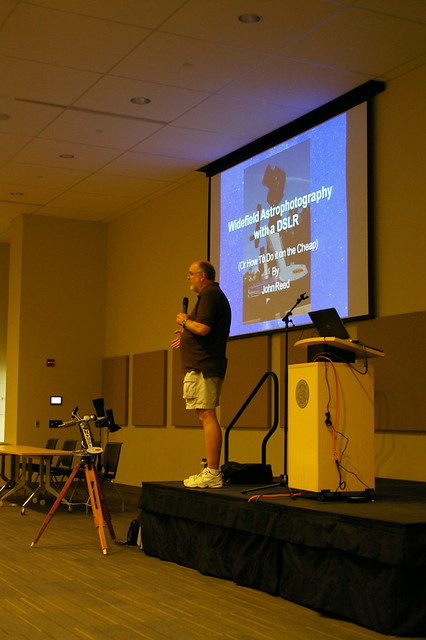
After a handulf of hours sleeping, I drug myself out of bed early Sundy morning. Rather than eating breakfast, I composed my blog post recapping Saturday at the MSRAL convention. I published at ten after eight o’clock, leaving me less than an hour to drive to UMKC from Lansing. The last day of the convention consisted of a morning dedicated to three workshops. Not knowing what I might need, I packed up my laptop and my DSLR camera and zipped down I-70, arriving with about ten minutes to spare.
I burdened myself with my laptop bag, camera backpack, purse and water bottle and trudged up the stairs to the Student Union. I opted not to take the additional four flights of stairs on the interior of the building, taking full advantage of the elevator to the top floor. I planted myself on the first row (as I’ve done each day of the convention) so I wouldn’t have any trouble hearing or seeing (or taking photographs like the one above).
Very interesting workshop on using consumer camera equipment (a Canon DSLR and a 200 mm telephoto with an AstroTrac mount) and some post-production work with Photoshop for stunning astrophotography.
The middle workshop presented by Jim Roe dealt with variable stars and doing some hands on scientific observation and research. I got to know his old friend Z Umi (a variable star in the Little Dipper).
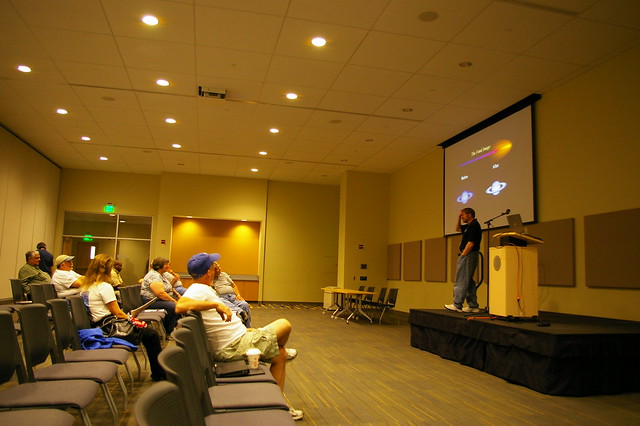
The final workshop of the day got really hands on, for those who wanted to participate in the step-by-step process of massaging web cam videos taken of Saturn to produce a nice crisp stacked image. The entire presentation will be uploaded to David’s website (Sunflower Astronomy) in the near future.
I learned so much and met some great people. I have many fascinating ideas and concepts revolving through my brain and many new projects I’m inspired to pursue. I look forward to attending similar conferences when they pass through the area again.
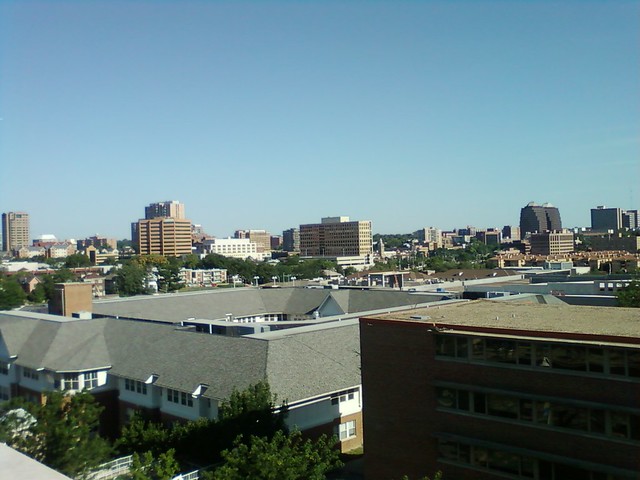
I survived the second day of the MSRAL convention. I think I overdosed on science, as my brain worked overtime while I slept to process the fascinating concepts, breakthroughs and forthcoming projects in astronomy and astrophysics I absorbed Saturday.
I arrived just in time to wait for the business meeting (scheduled for the eight o’clock hour) to run over into the first session. I strolled around the fourth floor of the UMKC Student Union, watching the venders setup their tables in the room adjacent to the main conference one. Several conference attendees also brought their solar telescopes and began setting them up on the rooftop deck of the building to facilitate solar observing throughout the entire day (and we had crystal clear skies for the duration).
Morning sessions:
I returned to the stairs leading from the third floor to the top floor of the Student Union for the group photo just before we broke for lunch. I ended up standing in the second row directly behind Fred Bruenjes (see local comet discoverer mentioned above).
Afternoon sessions:

Evening Keynote: LSST by Dr. Barbara Anthony-Twarog. Wow, just wow. This telescope, when it becomes operational (currently proposed completion and operational in 2022), will survey the sky like never before. All the data (15 terabytes per night) will be freely available to everyone (not just the US public, but the entire world). By the time it finishes its ten year run, there may be nothing left for traditional observers (both professional and amateur astronomers alike) to discover. The future of astronomical research will no longer rely on observations, but will need computer scientists and data miners to sift through the avalanche of data produced by the LSST.
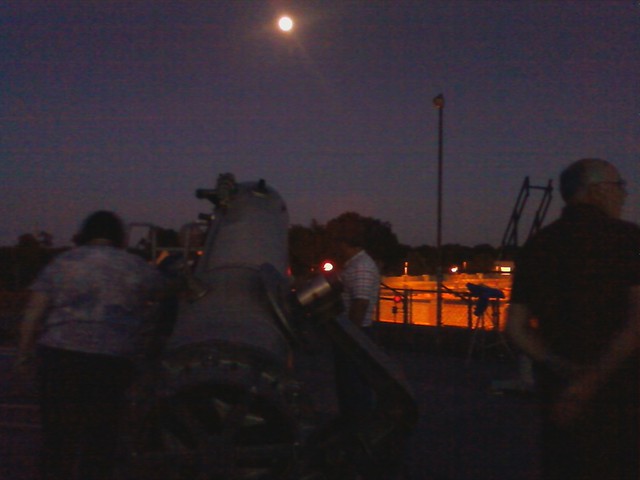
After Dark: Warko on the rooftop of Royall Hall
I moved my vehicle from the parking lot next to the Student Union to the parking garage next to Royall Hall, parking on the fourth level to take the sky bridge across to the building and then a couple of flights of stairs up to the rooftop observatory. The nearly full moon shone exceptionally bright on a clear, calm evening. We trained the 16 inch telescope on it, at least until the sky darkened enough to move on to other targets. I snapped a quick photo with my cell phone of the bright moon through the eyepiece:
We moved on to Saturn and stayed there until I had to leave (around 10:30) because I had a forty minute drive home and had been up since five.
I saw my first iridium flare last night. What is an iridium streak, you ask? Check out the Heavens Above web page to find out and to search for a streaker in your neighborhood (sky that is).
I enjoyed my second day at the convention. I learned more than I can possibly absorb on just five hours of sleep. In just a few minutes, I return for the final half-day of workshops. I’ll post my final thoughts later this afternoon, perhaps after I’ve had a nap.
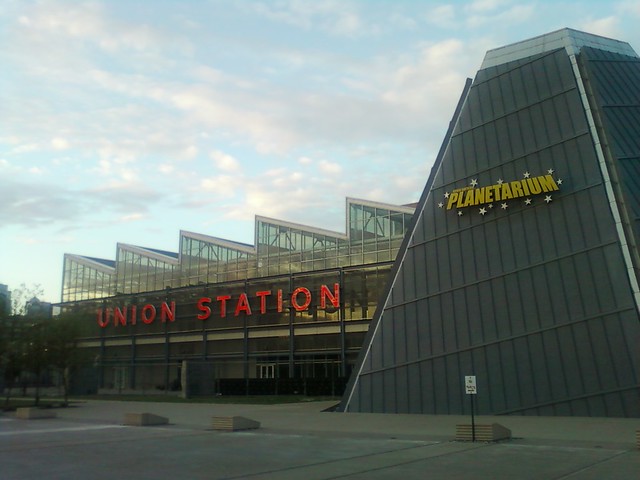
Since the late 80s, I have attended many conventions, all across the country. All of those conventions had one thing in common with the convention I’m attending this weekend in Kansas City: Science. Well, that’s not entirely true, those other conventions also included stars, but I’ll let that rest for a moment and wait for the shoe to drop.
Yep. I frequently attended science fiction conventions, mostly of the Star Trek flavor, but more recently of a more eclectic variety, culminating in a trip to Atlanta last fall to attend one of the largest in the country called Dragon*Con. I won’t be repeating the experience this fall. In fact, I could have attended the local science fiction convention, ConQuest, hosted annually over Memorial Day Weekend by the Kansas City Science Fiction and Fantasy Society. But none of the guests of honor intrigued me, so I decided to embark on a harder challenge.
 I registered early to attend the Mid-States Region of the Astronomical Leage (MSRAL) Convention and get a fix of hard science. I am a member of the Astronomical Society of Kansas City (ASKC), which in turn is a member of the Astronomical League.
I registered early to attend the Mid-States Region of the Astronomical Leage (MSRAL) Convention and get a fix of hard science. I am a member of the Astronomical Society of Kansas City (ASKC), which in turn is a member of the Astronomical League.
The convention started Friday evening at six o’clock with the Star-B-Que, catered by Jack Stack, at Union Station, followed by a program at the Gottlieb Planetarium.
Friday, of course, was a work day for me. Normally, I can make it home to Lansing by 5:25 p.m., after dropping off all my vanpool riders. Fortunately, one of my riders left early for a weekend trip, and it just happened to be the person whose home is fifteen minutes off my direct route home. So, I managed to make it back to Lansing by 5:10, giving me enough time to change clothes, put some gas in the car, and fly back to midtown Kansas City. I made it to I-670 and within sight of my goal by five ’til six. Then all traffic became a parking lot and I began to panic. I exited I-670 midway across the bottoms and took a slight detour around Kemper Arena, approaching Union Station from the west-southwest. I could not believe the amount of traffic! Something was going on, because streets were barricaded and people were flocking to the midtown and/or Crown Center area in droves. I wanted to scream! I finally wound myself through the mess, using an old shortcut I knew from my days of working next to Union Station (in the Two Pershing Square building) and arrived only ten minutes late.
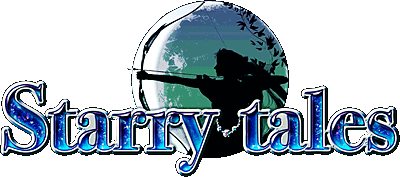 I picked up my registration packet and got in line for the barbecue. I sat at a table and met some new astronomers and reacquainted myself with some ASKC club members. Seven o’clock arrived quicker than I thought it would, and we all migrated to the planetarium for several very interesting programs presented by Jack Dunn of the Mueller Planetarium in Lincoln, Nebraska. He awed us with parts of several shows, including a moon tour via the Lunar Reconnaissance Orbiter, Jupiter via Science on a Sphere projection and a beautiful one created by Kagaya (a Japanese artist) called A Starry Tale. He closed the evening with a teaser trailer on the seventh planet, by popular request.
I picked up my registration packet and got in line for the barbecue. I sat at a table and met some new astronomers and reacquainted myself with some ASKC club members. Seven o’clock arrived quicker than I thought it would, and we all migrated to the planetarium for several very interesting programs presented by Jack Dunn of the Mueller Planetarium in Lincoln, Nebraska. He awed us with parts of several shows, including a moon tour via the Lunar Reconnaissance Orbiter, Jupiter via Science on a Sphere projection and a beautiful one created by Kagaya (a Japanese artist) called A Starry Tale. He closed the evening with a teaser trailer on the seventh planet, by popular request.

Announcements and updates followed and the disappointing news that neither Powell nor the Warko observatories would be opened up this evening, thanks to the clouds (see photo of sunset from Union Station at the left). So, I found myself heading west towards the sunset and home much earlier than I anticipated.
Today will be full of sessions and workshops. I can’t decide whether to take my laptop with me or not, as suggested during the announcements last night. It’s heavy and bulky and I’d have to worry about it and lug it around with me all day. I think I’ll forgo the hassle and rely on pen and paper and my Nook Color tablet for notes and research.
My only disappointment today will be not entering in the astrophotagraphy contest. I did not review the MSRAL Convention website well enough in advance to obtain quality prints of a few of my best photos from the last few months. The photos I would have entered are shown below (click images for larger versions).
 From my Mercury hunt in February 2012
From my Mercury hunt in February 2012

The first thing I do when I exit a building is look up. The only time I don’t do this is during inclement weather (usually defined as rain or snow or just overcast, but even clouds can be interesting). I try to locate the moon, if it’s supposed to be visible. If I can hear a flying vehicle (helicopter or prop plane or jet), I search the skies for them as well. I’ve given myself a crick in my neck and no few twisted ankles gazing skywards instead of watching where I was going. And my family just thought I was klutzy growing up. I decided to feature astronomy and telescopes for my eighth day of ‘Thirty Days of Thankfulness‘ series. The graphic to the left displays the skies above my house as they should appear the moment this post is published. If you’re reading this soon after it’s published, you’re either an insomniac or living down under. I will be sound asleep.

The big news for today is an asteroid visitor flying close to the Earth, inside the perimeter of the Moon’s orbit. The Sky & Telescope web page article includes a chart and instructions for observing the asteroid (best seen from North America and the instructions even mention Kansas and Kansas City by name!). Look for it late in the day (near sunset).
I am still blessed with good eyesight, at least of the far-seeing variety. My ability to read without assistance ended about five years ago thanks to my aging lenses in my aging eyeballs. Growing up with the space race in the 60s and 70s gave me not so much the astronaut bug but the astronomy one. I remember the first moon landing in 1969 and the first space shuttle launch in 1981. I still have the National Geographic magazines that featured the stunning photographs of Jupiter, Saturn, Mars, Neptune and Uranus from the Voyager Interstellar Mission (VIM). My grandfather, Daniel, worked for NASA‘s Ames Research Center as a glass blower and some of his work now rests on Mars from either the Mariner or the Viking missions.
I received my first telescope in the mid 70s as a Christmas gift from my dad. It was a three inch refractor that allowed me to view the moon, the planets and even a solar eclipse (by use of a clip-on white metal plate to project the image of the sun onto and avoid any eye damage). My parents stored the telescope while I was at college and while I started my family. Eventually, they brought it down to our home in Benton, where it sat neglected for the most part thanks to raising kids and working full-time. Sometime during the 90s, or during the move back to Leavenworth County, the telescope was either damaged or lost or both.
 Last year, as a birthday present, my father purchased a very nice Meade ETX-90 with several accessories and eyepieces, including an SLR digital camera (Pentax K100D – sans lenses). After a few months of fiddling and fine-tuning, I decided I could benefit from the wisdom of others and became a member of the Astronomical Society of Kansas City in the spring of this year. I tend to participate virtually and silently (for the most part) by following the group discussions and reading the monthly Cosmic Messenger newsletter I made it to two meetings this year and have not visited the Powell Observatory or tried the dark sky site, mostly because the cost of gasoline remained high and the weather for most of the summer did not cooperate by providing clear skies for optimal viewing opportunities.
Last year, as a birthday present, my father purchased a very nice Meade ETX-90 with several accessories and eyepieces, including an SLR digital camera (Pentax K100D – sans lenses). After a few months of fiddling and fine-tuning, I decided I could benefit from the wisdom of others and became a member of the Astronomical Society of Kansas City in the spring of this year. I tend to participate virtually and silently (for the most part) by following the group discussions and reading the monthly Cosmic Messenger newsletter I made it to two meetings this year and have not visited the Powell Observatory or tried the dark sky site, mostly because the cost of gasoline remained high and the weather for most of the summer did not cooperate by providing clear skies for optimal viewing opportunities.
Provided the world does not end next year, I plan to take a vacation involving astronomical observing and camping. We might attend something like the Texas Star Party or just spend a week near Kitt Peak National Observatory near Tucson, Arizona. I even thought of finding a camp site in the Flint Hills, because when we drove back north through them in early October, the skies were crystal clear and very dark,, with few trees to obstruct the horizon.
Astronomy Magazine – http://www.astronomy.com/
Sky and Telescope Magazine – http://www.skyandtelescope.com/
The Astronomical League – http://www.astroleague.org/
The International Dark Sky Association – http://www.darksky.org/
Hubble Space Telescope – http://hubblesite.org/
NASA’s Astronomy Picture of the Day – http://apod.nasa.gov/apod/astropix.html